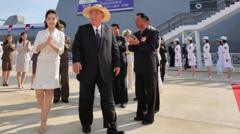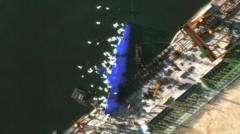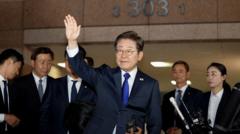The botched launch of North Korea's new warship has provided insight into Kim Jong Un's leadership style and the regime's evolving approach to public perception. By openly addressing the incident, Kim has demonstrated a shift towards transparency in managing failures while simultaneously using the event to reinforce loyalty to the regime and its goals of developing a nuclear-armed naval fleet.
North Korea's Warship Incident: A Shift in Strategy for the Regime

North Korea's Warship Incident: A Shift in Strategy for the Regime
Kim Jong Un's response to a warship capsizing reflects North Korea's evolving propaganda tactics and ambitions for a nuclear navy.
When North Korea's newly built warship capsized during its launch last month, it not only captured global attention but also offered a window into the complexities of Kim Jong Un’s leadership. Despite no casualties and minimal hull damage, the spectacle raised questions about the regime’s resilience and ambitions, particularly concerning naval capabilities in the context of nuclear armament.
Immediately denouncing the incident as a "criminal act" that tarnished national dignity, Kim swiftly ordered accountability and the restoration of the ship. This decisiveness led to the arrest of four party officials, revealing a regime that prioritizes control and rapid recovery after failure.
Experts note that Kim Jong Un’s frustration stems from North Korea’s perceived naval inferiority amid a growing nuclear arsenal. Recent developments reflect efforts to modernize the naval fleet, exemplified by the ship’s capability to theoretically launch nuclear short-range missiles—an aspiration Kim has pursued since he assumed power. The disconcerting nature of the capsizing exemplified the limitations of North Korean shipbuilding technology, especially under public scrutiny during the launch event, attended by Kim himself.
Interestingly, analysts argue that the publicized failure was a calculated move by the regime to bolster its image rather than conceal it. As North Korea grapples with increased information flow among its citizens, the leadership has shifted from silence to a more transparent acknowledgment of failures. Political strategist Rachel Minyoung Lee noted that by addressing issues head-on, the regime can reinforce the notion of accountability, showcasing both government capability and citizen loyalty.
The rapid successful relaunch of the capsized destroyer, completed in just over three weeks, served not merely as a recovery but as a demonstration of political triumph. Observers point out that this adaptability marks a significant departure from traditional North Korean propaganda, which historically clung to narratives of infallibility.
Even the tragic loss of a worker during construction was reframed as a symbol of dedication to foster loyalty among the populace, signifying a nuanced approach to leadership. As Kim seeks to transition North Korea's navy into an aggressive force capable of global operations, experts caution the international community to remain vigilant, recognizing the strategic advancements being made under Kim's directive.
What remains evident is a regime increasingly adept at leveraging obstacles into opportunities, thus reinforcing the underlying goal of establishing a formidable nuclear naval presence—a challenge that the global community must monitor closely.





















